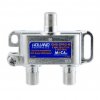The adapters (ECB6200K02) operate in the MoCA Extended D Band only, 1125-1675 MHz. The (likely) problem is that this is also within the operating frequency of DOCSIS 3.1.
That all depends on where @Unibrowser lives. The planned Docsis extension is for the first stage to run up to 1218 Mhz. The second stage is to run up to 1794 Mhz. You can work around the first stage extension. The second stage extension would require adapters to move up beyond 1794 Mhz. MoCA 3.0?? I've only read of one ISP that uses the first stage extension, which happens to be located in Europe, Denmark possibly? I haven't seen any announcements from North American ISPs indicating that they've moved their Docsis frequency range up into either of the planned extension ranges.
Even if that were the case, I doubt that the ISP is using the upper 1794 Mhz range. But, hey, anything is possible. This should be easy enough to figure out. @Unibrowser can set the adapters to use the D-High range for test purposes, which runs in the 1350 to 1675 Mhz range. That will keep the adapters out of the lower Docsis extension range. It will drop the adapter max data rate however, but, I'd only do this for test purposes. If that didn't change anything I'd discount the possibility that the adapters are running in the same frequency range as the modem.
@Unibrowser you asked if you could use a lower frequency. Maybe, and then .... maybe not. It depends on what the modems are configured for. It would appear that some ISPs may be using the OFDM channel for Docsis 3.1 operation on the downstream side, leaving the conventional QAM channels to serve as a backup in the case of an OFDM channel failure. In that case, you would have to know where those QAM channels are located by looking at the modem's DOCSIS WAN signal data. You might be able to configure the adapters to a avoid the lower QAM channel range but, I wouldn't guarantee success in that case. If the modem reboots for any reason, you could end up with a different QAM channel range which overlaps your specified adapter frequency range. So, that plan goes out the window.
And then, from posts in the DSLReports forums, it would appear that some ISPs may be using a hybrid configuration, running both QAM channels and the OFDM channel simultaneously on the downstream side. Same comments from above apply here. You might be able to configure the adapters to a lower range, but once again, a modem reboot could throw that out the window.
My thinking is that this is something else. A cabling issue, or connector issue possibly??
The adapter and modem should be configured as follows, from what I've read:
MoCA splitter -- RG-6 cable -- Adapter input --> Adapter output -- RG-6 cable -- modem -- ethernet -- router Wan port.
From the router you would have: Router LAN port -- ethernet -- Adapter ethernet port
I'd have a careful look at the RG-6 cable that runs from the adapter output to the modem. Take a look at both ends of the cable and ensure that the center copper conductor is not contacting any of the braided aluminum shield. If you happen to have another RG-6 cable that you can use for test purposes, I'd give that a try.
What happens when the adapters aren't connected? As in:
MoCA splitter -- RG-6 cable -- modem -- ethernet -- Router Wan port --> Router LAN port -- ethernet -- PC.
What do you get for data rates in that configuration?
Is there any chance that the external cable isn't connected properly to the MoCA splitter for some reason? That would explain the high internal data rates, accompanied with low internet data rates which rely on the connection to the neighbourhood node.
Edit: giving this some additional thought, @Unibrowser if you log into your modem and have a look at the DOCSIS WAN signal data, you should see the operating frequency for the OFDM channel. With a Hitron modem, the indicated frequency is probably the lower starting frequency of the OFDM channel. If the ISP is using the whole channel, it will run up 192 Mhz from that initial frequency. That data will tell you right away if the adapter D-Band is overlapping the modems OFDM channel.
Last edited:





